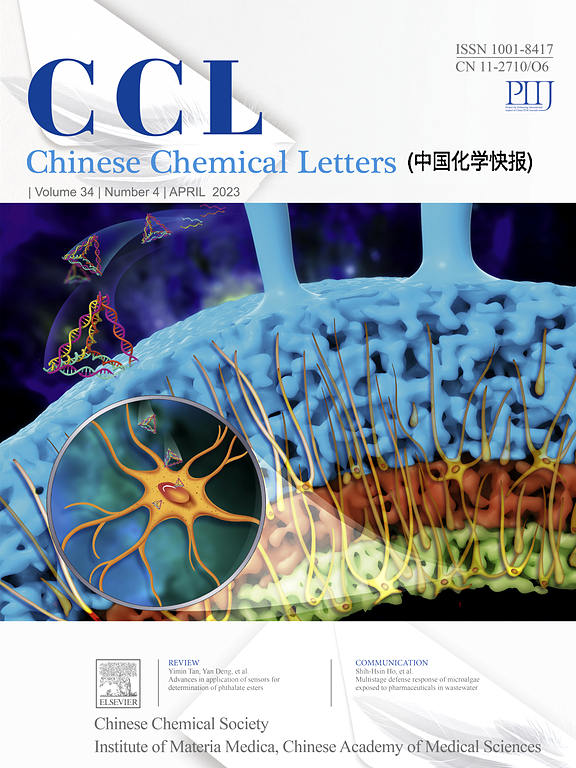P doped Ni3S2 and Ni heterojunction bifunctional catalysts for electrocatalytic 5-hydroxymethylfurfural oxidation coupled hydrogen evolution reaction
IF 9.4
1区 化学
Q1 CHEMISTRY, MULTIDISCIPLINARY
引用次数: 0
Abstract
The biomass electrochemical oxidation coupled with hydrogen evolution reaction has received widespread attention due to its carbon-neutral and sustainable properties. The electrosynthesis of 2,5-furanodicarboxylic acid (FDCA) from 5-hydroxymethylfurfural (HMF) oxidation is one of the most promising means for the production of bioplastic monomers. In this work, we constructed a novel P-doped Ni3S2 and Ni heterojunction on nickel foam (P-Ni3S2/Ni/NF) using electrodeposition methods and thermal sulfuration techniques as a bifunctional catalyst for the simultaneous anodic oxidation of HMF to FDCA (HMFOR) and the cathodic hydrogen evolution reaction (HER). On one hand, the synergistic promotion of P doping and the heterojunction of Ni3S2 and Ni accelerated electron transfer, and on the other hand, the structure of three-dimensional microsphere stacking on NF surface to form macropores enhances the exposure of catalytically active sites. The prepared P-Ni3S2/Ni/NF exhibited remarkable performance with high HMF conversion (99.2 %), FDCA yield (98.1 %), and Faraday efficiency (98.8 %), and excellent stability with good product selectivity for 7 consecutive cycles, which stands at a higher level than majority of previously published electrocatalysts. Furthermore, P-Ni3S2/Ni/NF also shows a significant response in HER. By using HMFOR and HER as the anodic reaction and cathodic reaction, respectively, the biomass upgrading and hydrogen production can be carried out simultaneously. The synthesized P-Ni3S2/Ni/NF only need a voltage of 1.31 V to achieve a current density of 10 mA/cm2 in a two-electrode system of HMFOR and HER, which is much lower than that of 1.48 V in OER and HER process, thus potentially reducing the cost of this process.

P掺杂Ni3S2和Ni异质结双功能催化剂电催化5-羟甲基糠醛氧化偶联析氢反应
生物质电化学氧化-析氢反应因其碳中性和可持续的特性而受到广泛关注。由5-羟甲基糠醛(HMF)氧化电合成2,5-呋喃二羧酸(FDCA)是生产生物塑料单体最有前途的方法之一。在本研究中,我们利用电沉积和热硫化技术在泡沫镍表面构建了一种新型的p掺杂Ni3S2和Ni异质结(P-Ni3S2/Ni/NF),作为HMF同时阳极氧化生成FDCA (HMFOR)和阴极析氢反应(HER)的双功能催化剂。一方面,P掺杂与Ni3S2和Ni异质结的协同促进加速了电子转移,另一方面,三维微球在NF表面堆积形成大孔的结构增强了催化活性位点的暴露。制备的P-Ni3S2/Ni/NF具有较高的HMF转化率(99.2 %)、FDCA产率(98.1 %)和法拉第效率(98.8 %),稳定性优异,连续循环7次的产物选择性好,高于大多数已发表的电催化剂。此外,P-Ni3S2/Ni/NF在HER中也表现出显著的响应。利用HMFOR和HER分别作为阳极反应和阴极反应,可以同时进行生物质升级和制氢。合成的P-Ni3S2/Ni/NF在HMFOR和HER双电极体系中只需1.31 V的电压即可达到10 mA/cm2的电流密度,远低于OER和HER工艺的1.48 V,从而有可能降低该工艺的成本。
本文章由计算机程序翻译,如有差异,请以英文原文为准。
求助全文
约1分钟内获得全文
求助全文
来源期刊

Chinese Chemical Letters
化学-化学综合
CiteScore
14.10
自引率
15.40%
发文量
8969
审稿时长
1.6 months
期刊介绍:
Chinese Chemical Letters (CCL) (ISSN 1001-8417) was founded in July 1990. The journal publishes preliminary accounts in the whole field of chemistry, including inorganic chemistry, organic chemistry, analytical chemistry, physical chemistry, polymer chemistry, applied chemistry, etc.Chinese Chemical Letters does not accept articles previously published or scheduled to be published. To verify originality, your article may be checked by the originality detection service CrossCheck.
 求助内容:
求助内容: 应助结果提醒方式:
应助结果提醒方式:


